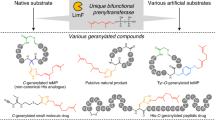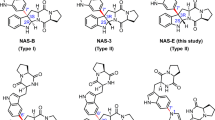Abstract
Aromatic prenyltransferases (aPTases) transfer prenyl moieties from isoprenoid donors to various aromatic acceptors, some of which have the rare property of extreme enzymatic promiscuity toward both a variety of prenyl donors and a large diversity of acceptors. In this study, we discovered a new aPTase, AtaPT, from Aspergillus terreus that exhibits unprecedented promiscuity toward diverse aromatic acceptors and prenyl donors and also yields products with a range of prenylation patterns. Systematic crystallographic studies revealed various discrete conformations for ligand binding with donor-dependent acceptor specificity and multiple binding sites within a spacious hydrophobic substrate-binding pocket. Further structure-guided mutagenesis of active sites at the substrate-binding pocket is responsible for altering the specificity and promiscuity toward substrates and the diversity of product prenylations. Our study reveals the molecular mechanism underlying the promiscuity of AtaPT and suggests an efficient protein engineering strategy to generate new prenylated derivatives in drug discovery applications.
This is a preview of subscription content, access via your institution
Access options
Subscribe to this journal
Receive 12 print issues and online access
$259.00 per year
only $21.58 per issue
Buy this article
- Purchase on Springer Link
- Instant access to full article PDF
Prices may be subject to local taxes which are calculated during checkout






Similar content being viewed by others

References
Brandt, W. et al. Molecular and structural basis of metabolic diversity mediated by prenyldiphosphate converting enzymes. Phytochemistry 70, 1758–1775 (2009).
Heide, L. Prenyl transfer to aromatic substrates: genetics and enzymology. Curr. Opin. Chem. Biol. 13, 171–179 (2009).
Li, S.M. Prenylated indole derivatives from fungi: structure diversity, biological activities, biosynthesis and chemoenzymatic synthesis. Nat. Prod. Rep. 27, 57–78 (2010).
Yazaki, K., Sasaki, K. & Tsurumaru, Y. Prenylation of aromatic compounds, a key diversification of plant secondary metabolites. Phytochemistry 70, 1739–1745 (2009).
Botta, B., Vitali, A., Menendez, P., Misiti, D. & Delle Monache, G. Prenylated flavonoids: pharmacology and biotechnology. Curr. Med. Chem. 12, 717–739 (2005).
Li, S.M. Applications of dimethylallyltryptophan synthases and other indole prenyltransferases for structural modification of natural products. Appl. Microbiol. Biotechnol. 84, 631–639 (2009).
Kuzuyama, T., Noel, J.P. & Richard, S.B. Structural basis for the promiscuous biosynthetic prenylation of aromatic natural products. Nature 435, 983–987 (2005).
Saleh, O., Haagen, Y., Seeger, K. & Heide, L. Prenyl transfer to aromatic substrates in the biosynthesis of aminocoumarins, meroterpenoids and phenazines: the ABBA prenyltransferase family. Phytochemistry 70, 1728–1738 (2009).
Chooi, Y.H. et al. Discovery and characterization of a group of fungal polycyclic polyketide prenyltransferases. J. Am. Chem. Soc. 134, 9428–9437 (2012).
Yu, X. & Li, S.M. Prenyltransferases of the dimethylallyltryptophan synthase superfamily. Methods Enzymol. 516, 259–278 (2012).
Rudolf, J.D., Wang, H. & Poulter, C.D. Multisite prenylation of 4-substituted tryptophans by dimethylallyltryptophan synthase. J. Am. Chem. Soc. 135, 1895–1902 (2013).
Ding, Y. et al. Genome-based characterization of two prenylation steps in the assembly of the stephacidin and notoamide anticancer agents in a marine-derived Aspergillus sp. J. Am. Chem. Soc. 132, 12733–12740 (2010).
Cheng, W. & Li, W. Structural insights into ubiquinone biosynthesis in membranes. Science 343, 878–881 (2014).
Kumano, T., Richard, S.B., Noel, J.P., Nishiyama, M. & Kuzuyama, T. Chemoenzymatic syntheses of prenylated aromatic small molecules using Streptomyces prenyltransferases with relaxed substrate specificities. Bioorg. Med. Chem. 16, 8117–8126 (2008).
Zhou, K., Yu, X., Xie, X. & Li, S.M. Complementary flavonoid prenylations by fungal indole prenyltransferases. J. Nat. Prod. 78, 2229–2235 (2015).
Yin, S., Yu, X., Wang, Q., Liu, X.Q. & Li, S.M. Identification of a brevianamide F reverse prenyltransferase BrePT from Aspergillus versicolor with a broad substrate specificity towards tryptophan-containing cyclic dipeptides. Appl. Microbiol. Biotechnol. 97, 1649–1660 (2013).
Kremer, A., Westrich, L. & Li, S.M. A 7-dimethylallyltryptophan synthase from Aspergillus fumigatus: overproduction, purification and biochemical characterization. Microbiology 153, 3409–3416 (2007).
Schuller, J.M. et al. Structure and catalytic mechanism of a cyclic dipeptide prenyltransferase with broad substrate promiscuity. J. Mol. Biol. 422, 87–99 (2012).
Pockrandt, D., Sack, C., Kosiol, T. & Li, S.M. A promiscuous prenyltransferase from Aspergillus oryzae catalyses C-prenylations of hydroxynaphthalenes in the presence of different prenyl donors. Appl. Microbiol. Biotechnol. 98, 4987–4994 (2014).
Mori, T. et al. Manipulation of prenylation reactions by structure-based engineering of bacterial indolactam prenyltransferases. Nat. Commun. 7, 10849 (2016).
Shen, Y. et al. Butyrolactone and cycloheptanetrione from mangrove-associated fungus Aspergillus terreus. Chem. Pharm. Bull. (Tokyo) 60, 1437–1441 (2012).
Gao, B., Chen, R., Liu, X., Dai, J. & Sun, F. Expression, purification, crystallization and crystallographic study of the Aspergillus terreus aromatic prenyltransferase AtaPT. Acta Crystallogr. F Struct. Biol. Commun. 71, 889–894 (2015).
Metzger, U. et al. The structure of dimethylallyl tryptophan synthase reveals a common architecture of aromatic prenyltransferases in fungi and bacteria. Proc. Natl. Acad. Sci. USA 106, 14309–14314 (2009).
Nitta, K., Fujita, N., Yoshimura, T., Arai, K. & Yamamoto, Y. Metabolic products of Aspergillus terreus. IX. Biosynthesis of butyrolactone derivatives isolated from strains IFO 8835 and 4100. Chem. Pharm. Bull. 31, 1528–1533 (1983).
Guo, C.J. et al. Spatial regulation of a common precursor from two distinct genes generates metabolite diversity. Chem. Sci. 6, 5913–5921 (2015).
Markovits, J. et al. Inhibitory effects of the tyrosine kinase inhibitor genistein on mammalian DNA topoisomerase II. Cancer Res. 49, 5111–5117 (1989).
Pavese, J.M., Krishna, S.N. & Bergan, R.C. Genistein inhibits human prostate cancer cell detachment, invasion, and metastasis. Am. J. Clin. Nutr. 100 (Suppl. 1), 431S–436S (2014).
Carmichael, J., DeGraff, W.G., Gazdar, A.F., Minna, J.D. & Mitchell, J.B. Evaluation of a tetrazolium-based semiautomated colorimetric assay: assessment of chemosensitivity testing. Cancer Res. 47, 936–942 (1987).
Yu, X. et al. Catalytic mechanism of stereospecific formation of cis-configured prenylated pyrroloindoline diketopiperazines by indole prenyltransferases. Chem. Biol. 20, 1492–1501 (2013).
Jost, M. et al. Structure-function analysis of an enzymatic prenyl transfer reaction identifies a reaction chamber with modifiable specificity. J. Am. Chem. Soc. 132, 17849–17858 (2010).
Krissinel, E. & Henrick, K. Inference of macromolecular assemblies from crystalline state. J. Mol. Biol. 372, 774–797 (2007).
Khersonsky, O. & Tawfik, D.S. Enzyme promiscuity: a mechanistic and evolutionary perspective. Annu. Rev. Biochem. 79, 471–505 (2010).
Chen, D. et al. Probing the catalytic promiscuity of a regio- and stereospecific C-glycosyltransferase from Mangifera indica. Angew. Chem. Int. Ed. Engl. 54, 12678–12682 (2015).
Cuetos, A. et al. Catalytic promiscuity of transaminases: preparation of enantioenriched β-fluoroamines by formal tandem hydrodefluorination/deamination. Angew. Chem. Int. Ed. 55, 3144–3147 (2016).
Ekroos, M. & Sjögren, T. Structural basis for ligand promiscuity in cytochrome P450 3A4. Proc. Natl. Acad. Sci. USA 103, 13682–13687 (2006).
Schmid, A. et al. Industrial biocatalysis today and tomorrow. Nature 409, 258–268 (2001).
Ho, B.K. & Gruswitz, F. HOLLOW: generating accurate representations of channel and interior surfaces in molecular structures. BMC Struct. Biol. 8, 49 (2008).
Woodside, A.B., Huang, Z. & Poulter, C.D. Trisammonium geranyl diphosphate. [diphosphoric acid, mono(3,7-dimethyl-2,6-octadienyl) ester (E)-, trisammonium salt]. Org. Synth. 66, 211 (1988).
Braña, M.F. et al. Synthesis and biological evaluation of analogues of butyrolactone I and molecular model of its interaction with CDK2. Org. Biomol. Chem. 2, 1864–1871 (2004).
McCoy, A.J. et al. Phaser crystallographic software. J. Appl. Crystallogr. 40, 658–674 (2007).
Murshudov, G.N. et al. REFMAC5 for the refinement of macromolecular crystal structures. Acta Crystallogr. D Biol. Crystallogr. 67, 355–367 (2011).
Pettersen, E.F. et al. UCSF Chimera--a visualization system for exploratory research and analysis. J. Comput. Chem. 25, 1605–1612 (2004).
Phillips, J.C. et al. Scalable molecular dynamics with NAMD. J. Comput. Chem. 26, 1781–1802 (2005).
MacKerell, A.D. et al. All-atom empirical potential for molecular modeling and dynamics studies of proteins. J. Phys. Chem. B 102, 3586–3616 (1998).
MacKerell, A.D. Jr., Feig, M. & Brooks, C.L., III. Improved treatment of the protein backbone in empirical force fields. J. Am. Chem. Soc. 126, 698–699 (2004).
Best, R.B. et al. Optimization of the additive CHARMM all-atom protein force field targeting improved sampling of the backbone ϕ, ψ and side-chain χ(1) and χ(2) dihedral angles. J. Chem. Theory Comput. 8, 3257–3273 (2012).
Yu, W., He, X., Vanommeslaeghe, K. & MacKerell, A.D. Jr. Extension of the CHARMM General Force Field to sulfonyl-containing compounds and its utility in biomolecular simulations. J. Comput. Chem. 33, 2451–2468 (2012).
Humphrey, W., Dalke, A. & Schulten, K. VMD: visual molecular dynamics. J. Mol. Graph. 14, 33–38, 27–28 (1996).
Acknowledgements
We thank S. Huang and J. He for their on-site assistance with the crystallographic data collection at the SSRF beamline BL17U. This work was supported by grants from the Strategic Priority Research Program of the Chinese Academy of Sciences (XDB08030202) to F.S., the National Basic Research Program (973 Program) of Ministry of Science and Technology of China (2014CB910700) to F.S. and (2014CB910202) to J.L., the National Natural Science Foundation of China (81302667) to R.C. and the Deutsche Forschungsgemeinschaft (Li844/4-1) to S.-M.L. The computational resources were provided by the National Supercomputing Center in Tianjin and the HPC-Service Station at the Center for Biological Imaging of the Institute of Biophysics of the Chinese Academy of Sciences.
Author information
Authors and Affiliations
Contributions
J.D., S.-M.L. and F.S. supervised the project. R.C., X.L., F.R., C.W. and K.F. performed the enzymatic and chemical experiments. B.G. performed the crystallographic and ITC experiments. Y.Z. and J.L. performed the molecular dynamics simulations. R.C., X.L., B.G., J.D. and F.S. analyzed the data and wrote the manuscript.
Corresponding authors
Ethics declarations
Competing interests
The authors declare no competing financial interests.
Supplementary information
Supplementary Text and Figures
Supplementary Results, Supplementary Tables 1–6 and Supplementary Figures 1–17. (PDF 2879 kb)
Supplementary Note
The spectroscopic data of identified catalytic products by AtaPT and the corresponding spectra. (PDF 10265 kb)
Rights and permissions
About this article
Cite this article
Chen, R., Gao, B., Liu, X. et al. Molecular insights into the enzyme promiscuity of an aromatic prenyltransferase. Nat Chem Biol 13, 226–234 (2017). https://doi.org/10.1038/nchembio.2263
Received:
Accepted:
Published:
Issue Date:
DOI: https://doi.org/10.1038/nchembio.2263
This article is cited by
-
De novo biosynthesis of the hops bioactive flavonoid xanthohumol in yeast
Nature Communications (2024)
-
Catalytic site flexibility facilitates the substrate and catalytic promiscuity of Vibrio dual lipase/transferase
Nature Communications (2023)
-
Phytochemistry and pharmacology of natural prenylated flavonoids
Archives of Pharmacal Research (2023)
-
Prenylation of dimeric cyclo-l-Trp-l-Trp by the promiscuous cyclo-l-Trp-l-Ala prenyltransferase EchPT1
Applied Microbiology and Biotechnology (2023)
-
Enigmatic persistence of dissolved organic matter in the ocean
Nature Reviews Earth & Environment (2021)


